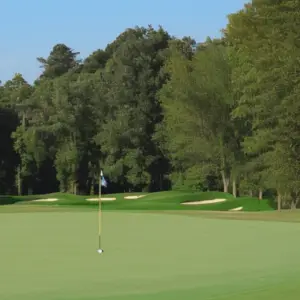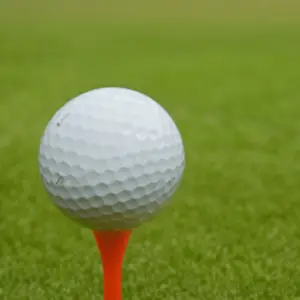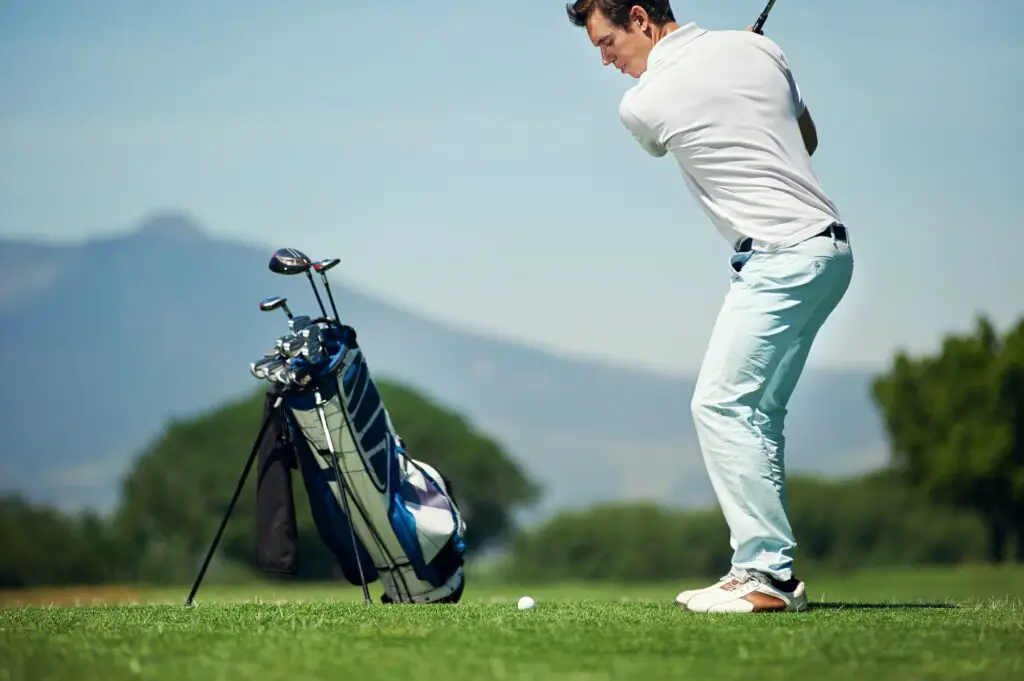Last Updated on May 31, 2023
Are you tired of hitting fades on the golf course? Do you want to know how to stop fading the golf ball? If so, then this post has the answers you seek. We’ll explore why your shots are fading and what steps can be taken to avoid it. From adjusting your grip, improving your swing path, and practising with alignment sticks – we have all the tips needed to help stop fading that pesky little white ball. So don’t wait any longer – let’s dive in and learn how to finally put an end to those frustrating fade shots.
Table of Contents:
- Understand the Causes of Fading
- Adjust Your Grip
- Improve Your Swing Path
- Practice with Alignment Sticks
- FAQs in Relation to How to Stop Fading the Golf Ball
- Conclusion
Understand the Causes of Fading
Fading in golf is one of the most frustrating issues for any golfer. It can be caused by a number of factors, including an open clubface, incorrect grip and poor swing path. Let’s take a closer look at each one so you can start to correct your fading shots.
An Open Clubface
An open clubface occurs when the face of the club points away from its intended target as it makes contact with the ball. This will cause your shot to curve off to the right (for right-handed players). To fix this issue, make sure that your hands are square on top of the shaft during setup and practice keeping them there throughout your swing.
Incorrect Grip
A poor grip often leads to an open clubface which results in a fade or slice shot. Make sure you’re gripping correctly by placing both hands on either side of the handle with equal pressure and ensuring that they form two straight lines down toward your target line (the imaginary line extending from where you want to hit towards where you want it to go).
Poor Swing Path
Your swing path also plays a role in how much fade or draw spin is imparted onto the ball upon impact – if it’s too far inside-out, then more spin will be added, causing increased curvature left or right depending on whether you’re playing ‘fade’ or ‘draw’ shots respectively. To fix this, work on making sure that your arms move back and through along their natural arc while maintaining good posture throughout – don’t forget about keeping those shoulders square.
Practising with alignment sticks can help ensure consistent swings. These simple tools allow you to check whether your body position remains consistent between swings, which helps build muscle memory over time and leads to more accurate fades or draws when playing in course conditions rather than relying solely on feeling alone.
Adjust Your Grip

Grip alteration is a critical element to avoid slicing the ball; an appropriate hold can provide a reliable swing trajectory and maintain clubface equitability at impact. A good golf grip will help you create a consistent swing path and keep your clubface square at impact. To adjust your grip, start by taking hold of the club with your left hand first, as this will be the foundation for all other adjustments.
Your left thumb should point straight down towards the ground when gripping the club. Make sure that it is not angled off to either side and that it does not wrap around too much on top of itself or rest in an uncomfortable position. Once your left hand is firmly set, place the right one on top with thumbs facing away from each other to avoid any clashes during the stroke and ensure a steady grip. This will ensure that they do not interfere with each other during the swing and allow you to maintain control throughout its entirety.
Rotate your hands counterclockwise to make them “under” rather than “over,” which will ensure proper alignment at the address and enhanced accuracy off the tee box. With less pressure, you can promote more wrist hinge through impact for added power while also minimising any unwanted fades or slices caused by incorrect contact points between clubhead and ball due to excessive tension or misalignment within the hands.
Finally, practice keeping everything loose yet secure during backswing without allowing either thumb to slip outwards, which could lead to misaligned shots. If done correctly, then once you reach the top-end transition phase into the downswing, there should already be some built-up momentum ready to go. Just remember: relaxed but firm equals better results; tense and tight equals worse ones. So take time to master these basics before moving on to anything else – if you get them dialled in, then the rest should fall into place pretty easily after that.
Improve Your Swing Path

One way to correct this issue is by focusing on the angle at which you take your backswing. A good rule of thumb for beginner golfers is to keep their club parallel to the ground when taking their backswing and follow through in a similar manner after impact. This will help ensure that you hit straight shots without any fade or draw.
Another key factor when it comes to avoiding fades is making sure that you don’t rotate too much during your downswing and follow-through phases. If you rotate too much, then it can cause the clubface to open up and result in a fade shot instead of a straight one. It’s also important not to close off the clubface, as this can lead to slices rather than fades. To avoid these issues, make sure that you maintain an even angle throughout both parts of your swing – from the address position all the way through until after impact.
Using alignment sticks can be very helpful when trying to improve your swing path as they provide visual feedback on where exactly you should be aiming each time before hitting a shot. Alignment sticks will give immediate feedback if there are any flaws in either part of your golf swing – backswing or downswing – so that corrections can be made quickly and easily without having guesswork involved in diagnosing what went wrong with each individual shot taken out on course.
Practice with Alignment Sticks

Practising with alignment sticks is a great way to improve your game and reduce fades. Alignment sticks are two long poles that can be placed in the ground or held by an assistant, which help you understand where you should aim and how to set up properly for each shot.
The first step is understanding what type of fade you have. If it’s a draw-fade, then aligning the alignment sticks parallel to your target line will help you keep the ball on track. On the other hand, if it’s a push-fade, then angling them away from your target line can help correct this issue. Knowing exactly what kind of fade you’re dealing with will make using alignment sticks much more effective when practising.
At address, position one stick behind and another ahead of you to practice proper synchronisation between arms during your swing. Focus on maintaining a connectedness between both arms through impact before releasing into the forward stick post-impact. This exercise will hone your body movement awareness during the swing, ultimately culminating in increased accuracy off the tee box.
Utilising these simple yet powerful tools correctly during practice sessions can dramatically increase the consistency of all clubs within any golfer’s bag, no matter their skill level. Setting them up perpendicular (at 90 degrees) from your intended target line will give an accurate representation of where your clubface needs to be pointed throughout every part of your short game stroke in order for shots not only to stay straight but also land precisely where desired.
FAQs in Relation to How to Stop Fading the Golf Ball
How do you control a fade in golf?
A fade in golf is a shot that curves slightly to the left (for right-handed players) as it travels through the air. To control a fade, you must start by setting up your body and clubface correctly. You should aim for an open stance with your feet pointing towards the target line and set up with an open clubface relative to your intended target line. When swinging, focus on making sure that your hands lead throughout the swing while keeping your arms straight and rotating fully through impact. Finally, use more of a sweeping motion instead of hitting down at the ball, which will help create a backspin necessary for fading shots.
Why am I fading the golf ball?
Fading the golf ball is a shot that can be used to increase accuracy and control. Hitting the ball with an open clubface produces a clockwise spin, creating a left-to-right trajectory (for righties) that diminishes slices and hooks. This spin makes the ball move slightly left-to-right (for right-handed players) and helps reduce slices or hooks off of your tee shots. Fading the golf ball requires practice, but once mastered can help improve your game significantly.
How do I keep my iron shots from fading?
To keep your iron shots from fading, you must focus on keeping a consistent swing path and clubface angle throughout the entire shot. Make sure to maintain an even tempo and stay in balance, with your weight evenly distributed between both feet. Also, ensure that you are swinging through the ball instead of trying to scoop it up at impact. Finally, be mindful of where your hands are during the backswing as well as how far they travel through impact – this will help create a draw or fade depending on what is desired for each particular shot.
Conclusion
By understanding the causes of fading, adjusting your grip and improving your swing path with alignment sticks, you can be sure to stop fading the golf ball. With practice and dedication, you will soon find yourself consistently hitting straight shots instead of fades. The key is to stay focused on each step while keeping an eye out for any potential flaws in the technique that could cause a fade shot.



